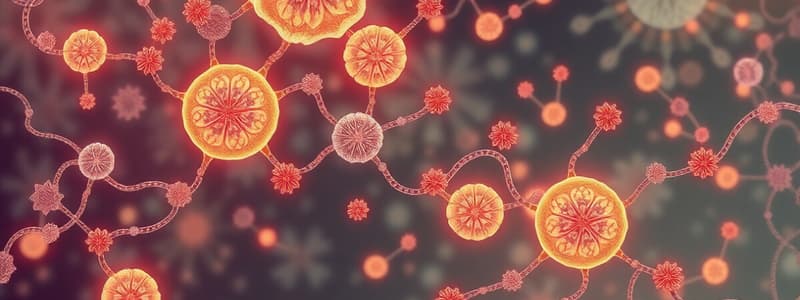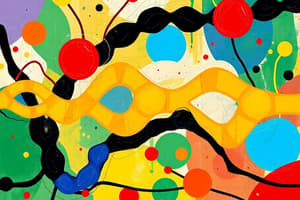Podcast
Questions and Answers
Which of the following macromolecules is primarily broken down in the glycolytic pathway?
Which of the following macromolecules is primarily broken down in the glycolytic pathway?
- Proteins
- Carbohydrates (correct)
- Nucleic acids
- Lipids
Which metabolic process is responsible for synthesizing new proteins in the body?
Which metabolic process is responsible for synthesizing new proteins in the body?
- Protein synthesis (correct)
- Lipogenesis
- Glycolysis
- Gluconeogenesis
Which of the following is NOT a major end product of lipid catabolism?
Which of the following is NOT a major end product of lipid catabolism?
- Acetyl-CoA
- Amino acids (correct)
- Fatty acids
- Glycerol
Nucleic acid metabolism involves the synthesis and breakdown of:
Nucleic acid metabolism involves the synthesis and breakdown of:
What is the net gain of ATP molecules produced per molecule of glucose during glycolysis?
What is the net gain of ATP molecules produced per molecule of glucose during glycolysis?
Which enzyme catalyzes the conversion of glucose to glucose-6-phosphate in the first step of glycolysis?
Which enzyme catalyzes the conversion of glucose to glucose-6-phosphate in the first step of glycolysis?
In the process of glycolysis, which molecule acts as the final electron acceptor to form lactate in anaerobic conditions?
In the process of glycolysis, which molecule acts as the final electron acceptor to form lactate in anaerobic conditions?
Which step in glycolysis is considered the ‘rate-limiting step’?
Which step in glycolysis is considered the ‘rate-limiting step’?
During glycolysis, glucose is ultimately broken down into:
During glycolysis, glucose is ultimately broken down into:
Which enzyme in glycolysis catalyzes the substrate-level phosphorylation that produces ATP?
Which enzyme in glycolysis catalyzes the substrate-level phosphorylation that produces ATP?
In which cellular organelle does glycolysis take place?
In which cellular organelle does glycolysis take place?
Which metabolic pathway is responsible for generating glucose from non-carbohydrate sources?
Which metabolic pathway is responsible for generating glucose from non-carbohydrate sources?
In aerobic conditions, pyruvate from glycolysis is converted into:
In aerobic conditions, pyruvate from glycolysis is converted into:
How many NADH molecules are produced per molecule of glucose during glycolysis?
How many NADH molecules are produced per molecule of glucose during glycolysis?
Which pathway involves the breakdown of triglycerides into fatty acids and glycerol?
Which pathway involves the breakdown of triglycerides into fatty acids and glycerol?
What is the main purpose of the urea cycle in amino acid metabolism?
What is the main purpose of the urea cycle in amino acid metabolism?
The breakdown of glucose in glycolysis produces pyruvate. In the presence of oxygen, pyruvate enters which cycle?
The breakdown of glucose in glycolysis produces pyruvate. In the presence of oxygen, pyruvate enters which cycle?
Which coenzyme is regenerated during the conversion of pyruvate to lactate under anaerobic conditions?
Which coenzyme is regenerated during the conversion of pyruvate to lactate under anaerobic conditions?
Which of the following molecules provides feedback inhibition to hexokinase in glycolysis?
Which of the following molecules provides feedback inhibition to hexokinase in glycolysis?
Which enzyme in glycolysis catalyzes the cleavage of fructose-1,6-bisphosphate into two three-carbon molecules?
Which enzyme in glycolysis catalyzes the cleavage of fructose-1,6-bisphosphate into two three-carbon molecules?
The final step of glycolysis, catalyzed by pyruvate kinase, produces pyruvate and:
The final step of glycolysis, catalyzed by pyruvate kinase, produces pyruvate and:
During fatty acid oxidation, each cycle of beta-oxidation produces which of the following?
During fatty acid oxidation, each cycle of beta-oxidation produces which of the following?
Which of the following is a precursor molecule for triglyceride synthesis?
Which of the following is a precursor molecule for triglyceride synthesis?
The presence of high levels of which molecule signals cells to start glycogen synthesis?
The presence of high levels of which molecule signals cells to start glycogen synthesis?
Which hormone stimulates the breakdown of glycogen to glucose in response to low blood sugar?
Which hormone stimulates the breakdown of glycogen to glucose in response to low blood sugar?
Flashcards
Glycolysis
Glycolysis
The metabolic pathway that breaks down carbohydrates (primarily glucose) into pyruvate, generating a small amount of ATP and NADH.
Citric Acid Cycle (Krebs Cycle)
Citric Acid Cycle (Krebs Cycle)
A series of reactions that occur in the mitochondria, oxidizing pyruvate from glycolysis to carbon dioxide, generating ATP, NADH, and FADH2.
Protein Synthesis
Protein Synthesis
The process of synthesizing new proteins from amino acids.
Lipolysis
Lipolysis
Signup and view all the flashcards
Glycogenolysis
Glycogenolysis
Signup and view all the flashcards
Glycogenesis
Glycogenesis
Signup and view all the flashcards
Lipogenesis
Lipogenesis
Signup and view all the flashcards
Gluconeogenesis
Gluconeogenesis
Signup and view all the flashcards
Lactate Fermentation
Lactate Fermentation
Signup and view all the flashcards
Inhibitor
Inhibitor
Signup and view all the flashcards
ATP Yield in Glycolysis
ATP Yield in Glycolysis
Signup and view all the flashcards
Hexokinase
Hexokinase
Signup and view all the flashcards
Phosphofructokinase
Phosphofructokinase
Signup and view all the flashcards
Rate-Limiting Step in Glycolysis
Rate-Limiting Step in Glycolysis
Signup and view all the flashcards
Final Step in Glycolysis
Final Step in Glycolysis
Signup and view all the flashcards
Location of Glycolysis
Location of Glycolysis
Signup and view all the flashcards
Pyruvate to Acetyl-CoA Conversion
Pyruvate to Acetyl-CoA Conversion
Signup and view all the flashcards
Urea Cycle
Urea Cycle
Signup and view all the flashcards
Beta Oxidation Products
Beta Oxidation Products
Signup and view all the flashcards
Insulin & Glycogen Synthesis
Insulin & Glycogen Synthesis
Signup and view all the flashcards
Glucagon & Glycogen Breakdown
Glucagon & Glycogen Breakdown
Signup and view all the flashcards
Glucose to Glucose-6-Phosphate
Glucose to Glucose-6-Phosphate
Signup and view all the flashcards
End Product of Glycolysis
End Product of Glycolysis
Signup and view all the flashcards
Pyruvate Enters Citric Acid Cycle
Pyruvate Enters Citric Acid Cycle
Signup and view all the flashcards
Glycerol in Lipid Synthesis
Glycerol in Lipid Synthesis
Signup and view all the flashcards
Aldolase
Aldolase
Signup and view all the flashcards
Glucose-6-Phosphate Feedback Inhibition
Glucose-6-Phosphate Feedback Inhibition
Signup and view all the flashcards
NAD+ Regeneration
NAD+ Regeneration
Signup and view all the flashcards
Fatty Acid Oxidation
Fatty Acid Oxidation
Signup and view all the flashcards
Study Notes
General Overview: Macromolecule Metabolism
- Carbohydrates are broken down in glycolysis.
- Protein synthesis is responsible for creating new proteins.
- Lipid catabolism does not produce amino acids. It creates fatty acids, glycerol, and acetyl-CoA.
- Nucleic acid metabolism involves DNA and RNA synthesis and breakdown.
Carbohydrate Metabolism: Glycolysis
- Glycolysis produces 2 ATP per glucose molecule.
- Hexokinase is the enzyme that converts glucose to glucose-6-phosphate in the first step of glycolysis.
- The rate-limiting step is the conversion of fructose-6-phosphate to fructose-1,6-bisphosphate.
- Glucose is broken down into two pyruvate molecules during glycolysis.
Integration of Metabolic Pathways
- Glycolysis occurs in the cytoplasm of the cell.
- Gluconeogenesis produces glucose from noncarbohydrate sources.
- Pyruvate is converted to acetyl-CoA in aerobic conditions.
- Pyruvate is converted to lactate in anaerobic conditions. NAD+ is regenerated.
- Glucose-6-phosphate inhibits hexokinase through feedback inhibition.
- Aldolase cleaves fructose-1,6-bisphosphate to two three-carbon molecules.
- The final step of glycolysis, catalyzed by pyruvate kinase, produces pyruvate and ATP.
Lipid Metabolism
- Lipolysis breaks down triglycerides into fatty acids and glycerol.
- Acetyl-CoA, NADH, and FADH2 are produced in each cycle of beta-oxidation.
- Glycerol is used to create triglycerides.
Metabolic Regulation
- Insulin signals cells to begin glycogen synthesis.
- Glucagon causes glycogen to be broken down to glucose when blood sugar is low.
Studying That Suits You
Use AI to generate personalized quizzes and flashcards to suit your learning preferences.
Related Documents
Description
This quiz covers the essential concepts of macromolecule metabolism, including carbohydrate metabolism through glycolysis, protein synthesis, lipid catabolism, and nucleic acid metabolism. Understand the key processes and pathways that integrate these macromolecules in biological systems.




